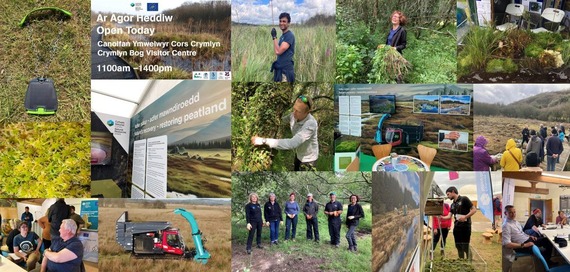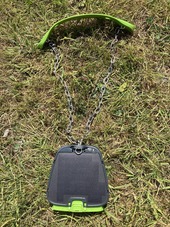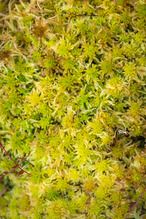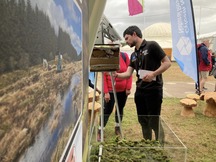|

There have been several significant moments in the story of our Crymlyn bog project site of late. Enormous strides forward in terms of delivering physical project works on the landscape itself, exciting developments in the engagement of local communities and also in pursuing our education and volunteering targets.
Following many months of planning and working with colleagues, stakeholders, land owners, contractors and local farmers, we have completed the restoration of a pre-existing track leading down onto the bog itself. The 1,400m track, costing just under £200,000 will now give direct access for heavy machinery (like “Pistenbully” Wetland Harvesters, pictured) to deliver large scale interventions on the surface of the bog. Huge thanks to St Modwen's Homes, The Port Tenant Canal Company and our NRW Integrated Engineering colleagues for enabling the build. Watch the short video diary of the track build here.
LIFEquake are also delighted to have established very meaningful relationships with local educators and community volunteers. Tutors from the Field Studies Council Margam have chosen to add the Crymlyn Reserve to their timetable of A level Environmental Science and Biology students as well as Key Stage 2 groups. This wonderful partnership will evolve over the coming years and bring many learners onto the site to enjoy the and learn about the ecology, evolution and restoration of wetland habitats and also carbon sequestration of functioning peat bogs.
Kilvey Hill Community Volunteers, a well-established and highly active group of people local to Crymlyn have now been formally granted access to the visitor centre for their regular events, conservation and woodland craft sessions. LIFEquake have long admired the group and are excited to now be working with them and supporting them in their own endeavours and to benefit the habitat at Crymlyn.
It was a pleasure to meet with Rick Hughes, chairman of the Tennant Canal Association. Rick gave a fascinating insight into the history of the waterways around Crymlyn – most notably the Glan y Wern Canal which extends directly across the bog itself. Here’s a short video we created with Rick.
|
|

One of the best ways to maintain the surface of a bog is to use animals to graze it. A lot of these habitats are in poor condition due to either no grazing or in some cases too much grazing. A big part of the LIFEquake project is to engage with farmers to create the best ways to sustainably graze the land. Over the lifetime of the project we will install around 50km of fencing on project sites to enable safe and manageable grazing, but in some locations and due to the type of terrain, installing physical fences might not be an option…and that’s why we’re trialling a virtual fencing system.
The technology consists of a battery-powered GPS collar and a virtual boundary. The collar communicates with an App which allows farmers to track the animals' movements. The virtual fences can easily be adjusted or moved, giving animals access to new areas and fresh pastures. When the animal crosses a boundary, the collar emits a warning.
LIFEquake has purchased 30 of these collars and is now working with and training farmers on the use of this innovative solution to grazing bogs!
|
|
|

In April, LIFEquake team leader Matthew Lowe and Senior Project Officer Gareth Thomas journeyed to Berlin to attend the European LIFE Peatlands Conference. There were twenty-five other LIFE funded peatland restoration projects from across Europe also in attendance sharing experiences, disseminating best practice, networking and celebrating successes.
Keynote speakers and peatland specialists from within the EU delivered workshops and presentations and there were opportunities to visit nearby project sites to observe different restoration techniques in practice.
Some fascinating, challenging and quite alarming facts were shared during the conference – most notably that 1 hectare of degraded peatland releases as much CO2 as driving a car for 143,000km per year and that the EU needs to re-wet 500,000ha of drained peatland per year to meet Paris Agreement. The reassurances came from witnessing just how many different projects in so many different countries were focused on delivering this hugely important intervention.
|
|
|

A significant find at LIFEquake project site Rhos Goch occurred in July – a rare, red moss – ‘sphagnum divinum’. These large, red Sphagnum mosses are rare in Wales and are almost entirely restricted to peat bogs that have not been drained. However, in the last 15 years colonies of large, red sphagnum have been found in transition mire vegetation at scattered sites across Wales.
Many of these transition mires are developing in former peat cuttings, and the large, red sphagnum are important peat formers so their appearance in the cuttings gives hope that peat will again start forming in these damaged areas. Almost all the large, red Sphagnum that has been checked microscopically in recent years has proved to be sphagnum medium rather than the rarer sphagnum divinum. This is the first record for the southern half of Wales and its presence in the transition mire at Rhos Goch suggests that peat formation is continuing onsite.
|
|
|

Event season was a huge success – and it was wonderful to see that on both corporate show stands (most notably, the award winning RWS stand) that peatland restoration featured so prominently. Members of the LIFEquake team were represented on each of the days at both shows and seized the opportunity to speak with interested members of public and farmer about the project and benefits of restoring this valuable habitat.
A bog-in-a-box was part of the exhibit and gave people the opportunity to get their hands amongst some sphagnum moss to appreciate the incredible ability it has to store water. A video played throughout the shows giving a unique aerial view of the different peatland landscapes in Wales. The film was created by LIFEquake Communications officer Mark, who had recently qualified as a commercial drone pilot and was subsequently able to contribute many fly-throughs of LIFEquake sites.
Watch the video here.
|
Keep up to date with our progress…
Visit our webpage for all the latest news about the project, or follow @LIFE Quaking bogs on our social media feeds.
Website: Natural Resources Wales / LIFE Quaking Bogs
Email: lifecorsyddcrynedig@cyfoethnaturiolcymru.gov.uk
|
|
|
|